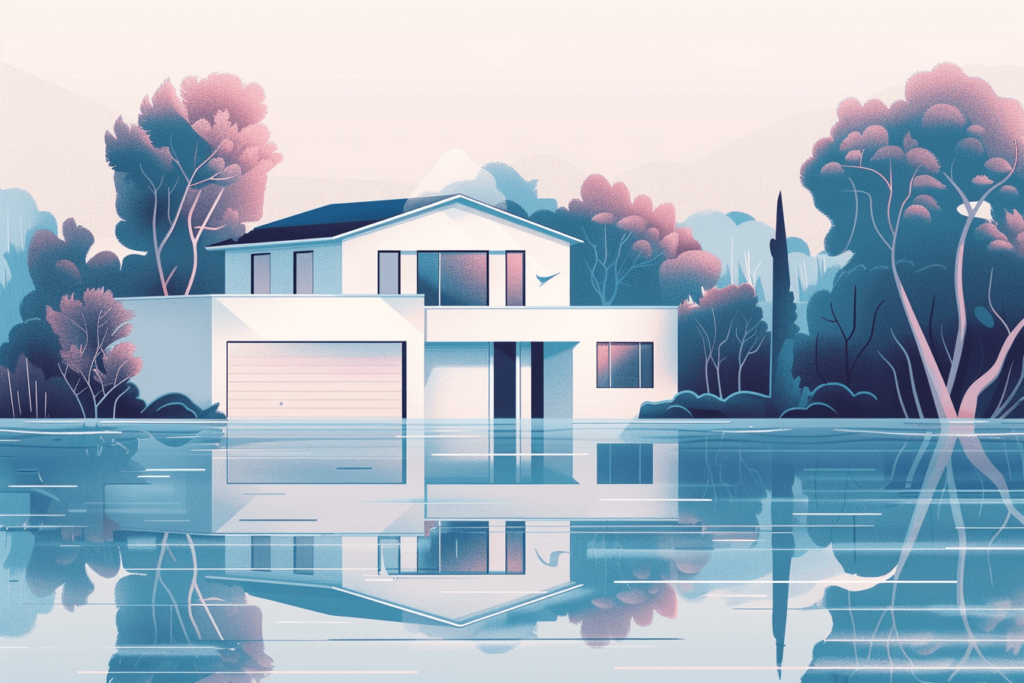Homeowners insurance covers damage caused by hail, fire, theft and other perils. If you purchase a comprehensive policy, it may even cover detached structures and personal belongings. No matter how much coverage you have, however, standard homeowners insurance doesn’t cover damage caused by flooding.
If you live in a flood-prone area, you need extra protection. Learn what flood insurance is and why you should consider paying for flood insurance benefits.
What Is Flood Insurance?
Flood insurance is a certain type of insurance policy designed to compensate homeowners for damage caused by flooding. FEMA defines a flood as an excess of water on land that’s usually dry. Under FEMA guidelines, the excess of water must affect at least two properties or 2 acres of land to qualify as a flood.
What Does Flood Insurance Cover?
Flood insurance comes with two different types of coverage: dwelling (building) coverage and contents coverage. Dwelling coverage refers to the structure of your home and any fixed appliances. A fixed appliance, meaning one that is permanently connected to your home. For example, an oven is connected to a fused outlet, making it a fixed appliance.
Depending on the extent of the flooding, a flood insurance policy may cover the following:
- Furnaces
- Water heaters
- Electrical systems
- Plumbing systems
- Foundation walls
- Solar energy equipment
- Staircases
- Permanently installed bookcases or cabinets
- Detached garages
- Permanently installed carpeting
- Well pumps
- Fuel tanks
Contents coverage protects the items inside your home. For example, if flooding destroys some of your clothing, your insurer may reimburse you. Contents coverage typically covers the following:
- Clothing
- Personal electronics
- Non-fixed appliances (e.g., washer, dryer)
- Microwaves
- Window air conditioner units
- Furniture
- Carpets that aren’t permanently installed
- Curtains
Contents coverage may also reimburse you for damaged or destroyed furs, artwork and other valuable items. However, this coverage is somewhat limited. However, your insurer may reimburse you up to $2,500.
What Doesn’t Flood Insurance Cover?

Even the most comprehensive flood insurance policies don’t cover everything. Your policy may not reimburse you for losses related to the following:
- Temporary housing: If a flood forces you to move out of your home while a contractor makes repairs, your flood insurance benefits won’t cover the cost of temporary housing.
- Business interruption: Residential flood insurance covers the structure of your home and its contents. It doesn’t cover any losses resulting from an interruption of business operations. For example, if you lose a client because flooding prevented you from filling an order on time, your insurance carrier won’t reimburse you.
- Property stored in your basement: When flooding occurs, water usually enters the basement first, making it a high-risk area. As a result, your insurer won’t cover any property stored in your basement, even if your policy typically covers that type of property.
- Outdoor property: Flood insurance doesn’t cover swimming pools, patios, decks, hot tubs and septic systems.
- Valuable papers: If you’re in a flood-prone area, you may want to pay for a safe deposit box at your local bank, as flood insurance doesn’t cover stock certificates, currency and other valuable papers.
- Precious metals: Flood insurance benefits don’t include coverage for precious metals, so if you have gold bars or silver coins, make sure they’re stored in a safe place.
Who Needs Flood Insurance Benefits?
If you live in a high-risk flood area and got your mortgage through a government program, you’re required to maintain flood insurance on your property. This includes mortgages backed by the Federal Housing Administration and the Department of Veterans Affairs.
You may also need flood insurance benefits if you’ve ever received disaster assistance from a federal agency. For example, if the U.S. Small Business Administration gave you a low-interest disaster loan, you’ll need to purchase a flood insurance policy to ensure you have adequate coverage going forward.
Flood Zones
Every home has some risk of flooding, but the risk is higher in some areas than others. FEMA uses flood zones to help you understand the level of risk present in your community. For example, Zone A has a high risk of flooding, so homeowners in this zone must purchase flood insurance if they have government-based mortgages.
Zones V and VE are also high-risk communities, as they’re located in coastal areas with frequent storms. FEMA estimates that communities in Zone V and ZE have a 26% chance of flooding over a 30-year loan term.
Zones C and X have the lowest risk of flooding, while Zones B and X have moderate risk levels. If your community is in Zone D, the risk of flooding is unknown. Your insurance company may charge a little more for flood insurance due to the level of uncertainty involved in determining the likelihood that you’ll have to file a flood claim at some point.
Which Companies Offer Flood Coverage?
Three major companies offer flood insurance benefits to U.S. homeowners: Farmers, Allstate and Liberty Mutual. You may also be able to purchase a policy from the National Flood Insurance Program. NFIP insurance is generally more affordable than the flood insurance offered by private companies. However, NFIP policies have coverage limits that make them unsuitable for some homeowners.
For example, NFIP insurance limits your building coverage to $250,000. If you live in an area with a low cost of living, that amount of coverage may be just fine. However, home prices have risen rapidly. In many cities, you can’t purchase a home for $250,000 unless it’s a total fixer-upper. In fact, the U.S. median home price exceeded $420,000 in the first quarter of 2024. As a result, many homeowners are turning to private insurers when they need flood insurance benefits.
You might also be interested in: 9 Tips For Staying Safe During A Hurricane




